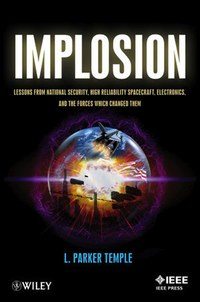Review: Implosionby Jeff Foust
|
| “High reliability electronic parts were and are fundamental elements of U.S. national security and defense, the economy, and long-lived spacecraft,” Temple writes. |
Those costs have led some to wonder why satellites can’t be made less expensive. For example, are the expensive space-rated electronics used in spacecraft, often generations behind comparable terrestrial systems, really necessary? Some have advocated greater use of “commercial off-the-shelf”, or COTS, electronics on spacecraft in place of space-rated systems. However, a space industry veteran argues that past efforts at such reform show that such initiatives threaten the reliability of spacecraft and, with them, national security.
L. Parker Temple III offers a history of both space-rated electronics and government procurement in Implosion. “High reliability electronic parts were and are fundamental elements of U.S. national security and defense, the economy, and long-lived spacecraft,” Temple writes. “A convergence of many different factors, forces if you will, combined to bring a highly successful enterprise to an end.”
Over a half-century ago, advances in electronics were stimulated and supported in large part by the requirements and budgets of government customers, particularly the military. Development of ICBMs and other missiles pushed the state of the art of electronics that, given their use, had to work reliably and often in harsh conditions, including exposure to radiation. During the production of the Minuteman III ICBM, Temple writes, the missiles represented 65 percent of the demand for integrated circuits. (Temple focuses on military use of electronics as opposed to NASA’s use in the book, but suggests that the military played a much larger role in stimulating demand for electronics during the early Space Age than NASA.)
This early large investment in military-grade electronics helped advance the American electronics industry in general. “Minuteman infused money to solid state industries and raised the overall quality of parts for all users,” Temple writes. In the 1970s, though, the situation changed. Commercial demand for electronics skyrocketed as advanced in microchips enabled electronic calculators, personal computers, and other devices. By the 1980s, military demand for so-called “Class S” electronics, specifically designed for the space environment, was only a small fraction of the overall electronics market. Space and other military applications were no longer driving the market.
| Temple rightly concludes that this history “teaches that poorly understood, radical changes to complex systems are unwise and do not fare well.” |
With the end of the Cold War, the 1990s brought with it full-fledged acquisition reform at the Defense Department, and with it a push for greater use of commercial technologies and approaches. (There were more limited attempts at acquisition reform in the 1980s specific to space-rated electronics, Temple notes, including bulk buys of these electronics to be used by multiple military and civil programs; these met with only limited success.) These attempts to save money led instead to cost overruns on major military space programs and a decline in quality that resulted in several notorious launch failures in the late 1990s and problems with satellites after launch. Since then, there has been a general refrain in policy circles that “space acquisition is broken.”
Implosion is a mix of a history of electronics, particularly space-related components, and a history of government procurement: two issues that, singly or in combination, can cause one’s eyes to glaze over. (The “expectation that a history of high reliability electronics will enflame the passions of a reader… is probably a stretch,” Temple admits in the book’s preface.) He dives deep into the details of both technology and policy in the book, although in the latter chapters his emphasis is more on acquisition reform and other policy issues than on the electronics themselves. He does not, for example, go into the technical details of the numerous satellites he says experienced failures because of this change of approach.
Temple mourns the loss of the system established in the 1960s and ’70s that created highly reliable spacecraft, but acknowledges that turning back the clock to those good old days isn’t an option. At the end of Implosion, he offers several potential solutions, from greater investment in and smarter procurement of space-rated electronics, to on-orbit repair of satellites, to simply accepting higher failure rates of spacecraft and thus launching them more frequently. He is not particularly fond on those latter two options, although satellite servicing does perhaps show some potential, albeit in the long term. While a solution isn’t clear, Temple rightly concludes that this history “teaches that poorly understood, radical changes to complex systems are unwise and do not fare well.”
